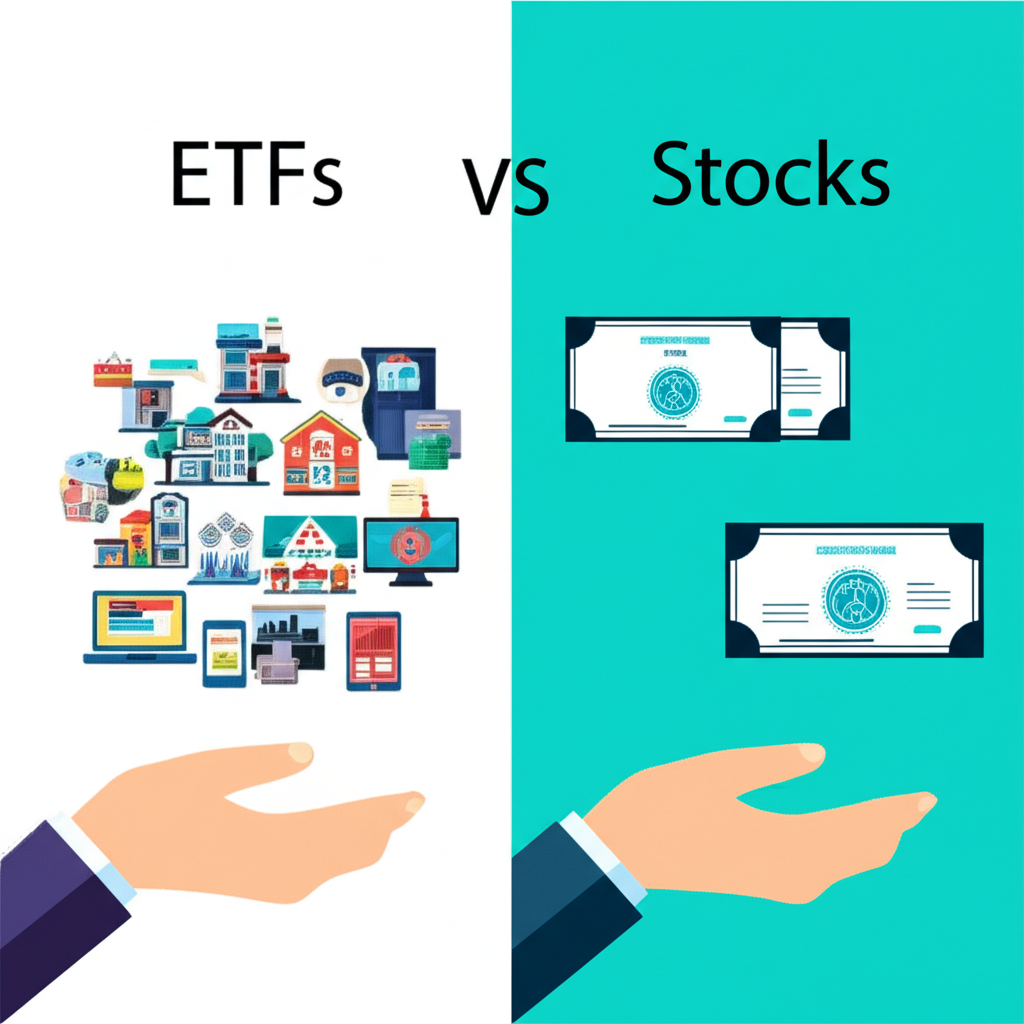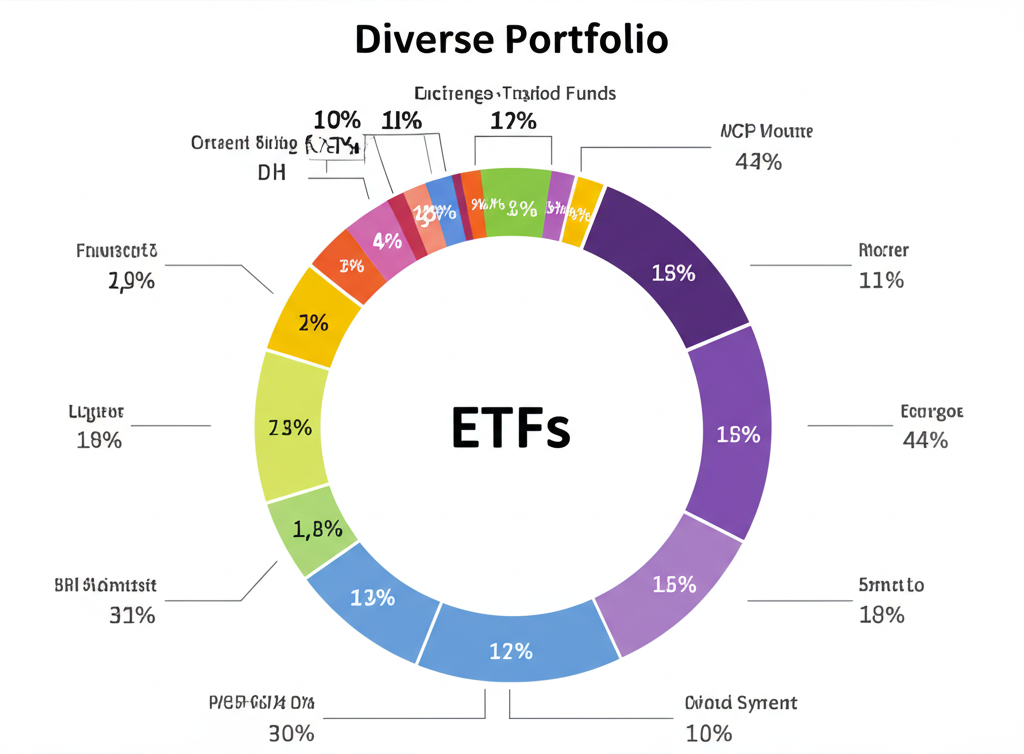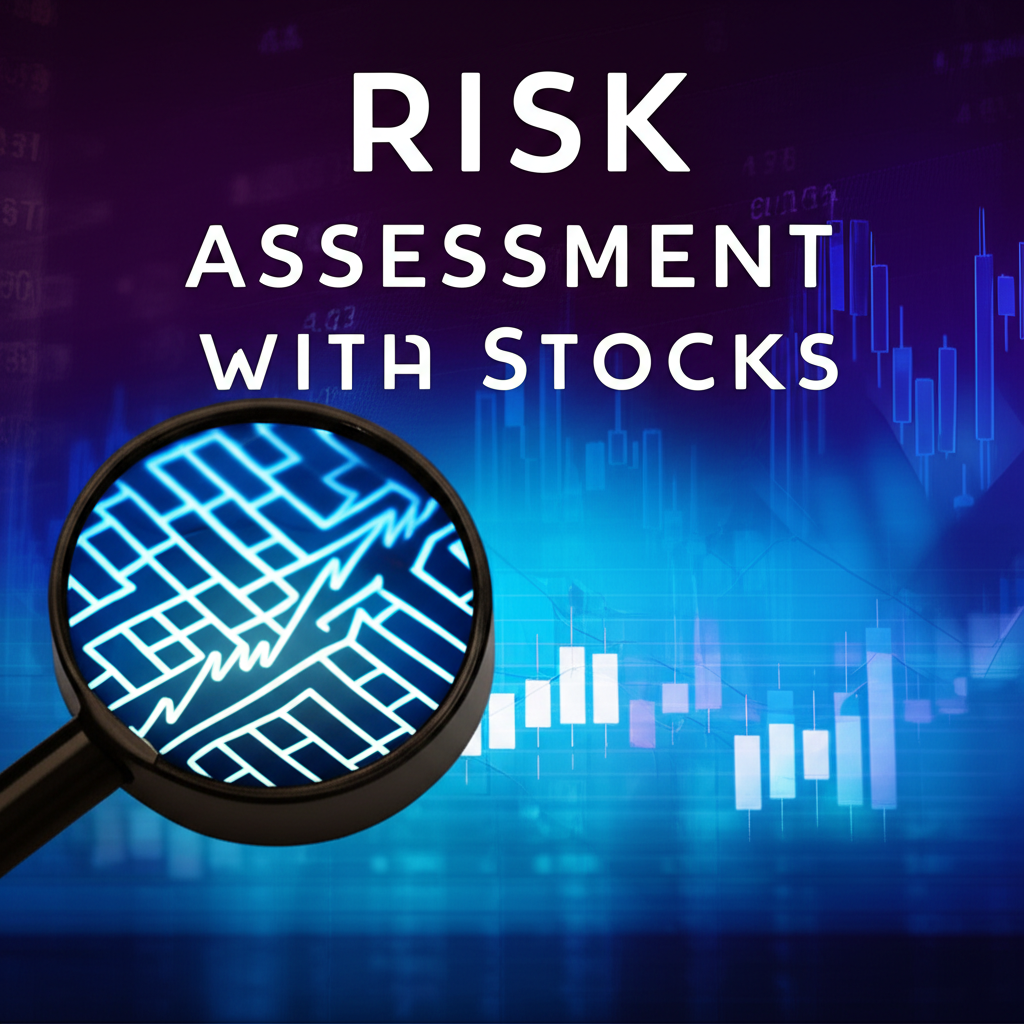ETFs vs. Stocks: Navigating Your Investment Path for Wealth Growth
Have you ever wondered how to make your money work harder for you, but felt overwhelmed by all the investment jargon? You’re not alone! Many people are curious about building wealth but aren’t sure where to start. Today, we’re going to demystify two of the most popular investment options: **Exchange-Traded Funds (ETFs)** and **individual stocks**. We’ll explore what they are, how they differ, and which one might be a better fit for your financial journey. Understanding these key distinctions is crucial for making smart choices that align with your personal financial goals, how much risk you’re comfortable with, and how much time you want to spend managing your money.
Embarking on your investment journey requires a clear understanding of the tools at your disposal. While the financial landscape can appear complex, breaking down options like ETFs and individual stocks into their fundamental components can simplify your decision-making process. Both offer distinct pathways to potential growth, but they cater to different investor profiles and objectives. By exploring their unique characteristics, you can strategically align your investment choices with your personal financial vision.

Understanding the Basics: What Are ETFs and Stocks?
Let’s start with the fundamentals. Think of **investing** as planting a seed today in hopes of growing a tree tomorrow. But what kind of seed should you plant?
First, let’s talk about **ETFs**. An ETF is essentially a basket of different investments, like stocks, bonds, or commodities, all bundled together. When you buy a share of an ETF, you’re buying a tiny piece of that entire basket. Many ETFs are designed to track a specific **index**, like the S&P 500 Index, which represents 500 of the largest U.S. companies. This means the ETF’s performance will generally mirror the performance of that index. ETFs are traded on major stock exchanges throughout the day, just like individual stocks. They’ve become incredibly popular, with their **assets under management (AUM)** reaching an impressive US$11.1 trillion by December 31, 2023, a testament to their efficiency and flexibility.

There are many different types of ETFs to suit various investment goals:
- Stock ETFs: Invest in a collection of company stocks, often focused on a specific industry (like technology or healthcare) or market size (like large-cap or small-cap companies).
- Bond ETFs: Hold various types of bonds, providing income and generally lower volatility than stock ETFs.
- Commodity ETFs: Invest in physical commodities like gold, oil, or agricultural products.
- Currency ETFs: Track the performance of specific currencies, like the U.S. dollar or the Euro.
- Specialty ETFs: These can be more complex, including leveraged ETFs (which aim to amplify returns, but also losses) or inverse ETFs (which profit when the market goes down).
Beyond the various categories, ETFs are also characterized by several key aspects that influence their utility for investors:
- Cost Efficiency: Generally known for lower operating expenses compared to actively managed mutual funds, making them an attractive option for long-term growth.
- Transparency: Most ETFs disclose their holdings daily, allowing investors to know exactly what they own.
- Liquidity: Traded on exchanges like stocks, meaning they can be bought and sold throughout the trading day at market prices.
Now, let’s look at **individual stocks**. A stock represents a tiny piece of ownership in a single public company. When you buy a share of Apple Inc. or Microsoft, you become a part-owner of that specific company. The value of your **stock** is directly tied to how well that company performs and how investors feel about its future prospects. When the company does well, its stock price might go up, increasing your **capital appreciation**. Some companies also pay out a portion of their profits to shareholders as **dividends**.

Stocks can be broadly categorized by their **market capitalization**, which is the total value of all their outstanding shares:
- Large-cap Stocks: These are shares of big, established companies (like Amazon or J.P. Morgan) that are often stable and have a consistent track record.
- Mid-cap Stocks: These belong to companies that are still growing but are larger than small-caps, offering a balance of growth potential and moderate stability.
- Small-cap Stocks: These are shares of smaller companies (like Etsy or Zillow) with high growth potential but also higher **risk** and **volatility**.
When considering individual stocks, investors often focus on specific attributes that signal a company’s potential:
- Growth Potential: The capacity for a company’s earnings and revenue to increase significantly over time, driving stock price appreciation.
- Value Proposition: Identifying companies whose stock prices appear undervalued relative to their intrinsic worth, offering a potential for future gains as the market recognizes their true value.
- Sector Influence: How a company’s performance is tied to broader trends within its industry, such as technological innovation or consumer shifts.
The Core Distinctions: Diversification, Risk, Costs, and Management
So, how do ETFs and individual stocks stack up against each other? Let’s break down the key differences that could influence your **investment strategy**.
The choice often boils down to how much **diversification** you want, the level of **risk** you’re willing to take, the **costs** involved, and how hands-on you want to be with your **portfolio** management. Which of these factors do you think is most important for a beginner investor?
To visually underscore the fundamental differences, consider this illustration that encapsulates the core characteristics of each investment vehicle:

Here’s a simple comparison table to highlight the core distinctions:
| Feature | ETFs (Exchange-Traded Funds) | Individual Stocks |
|---|---|---|
| Diversification | Offers instant, broad diversification across many assets. Spreads out risk. | Provides concentrated exposure to a single company. Higher risk. |
| Risk Profile | Generally lower risk due to diversification; market downturns impact many companies, but not just one. | Higher risk; performance is solely dependent on the individual company, leading to more volatility. |
| Costs | Incur an annual “expense ratio” (a small percentage of your investment) and potential brokerage commissions when buying/selling. | Primarily brokerage fees for buying/selling (often negligible or zero on many platforms now). No ongoing management fees. |
| Management Style | Mostly passively managed, tracking an index. Less research needed from the investor. | Requires active research, monitoring, and decision-making about specific companies. |
| Growth Potential | Growth is generally capped by the average performance of the index or sector it tracks. | Potential for significant capital appreciation if a “wonderful company” outperforms the market. |
Weighing the Benefits and Drawbacks: A Balanced Perspective
Every investment tool has its bright sides and its challenges. Understanding these will help you make a more informed decision about your **investment portfolio**.
Let’s look at the **advantages and disadvantages** of each:
Pros of Investing in ETFs:
- Instant Diversification: With a single purchase, you get exposure to many **securities**, reducing the impact if one company performs poorly. This is a powerful way to manage **risk**.
- Lower Volatility: Because your **investment** is spread out, broad market ETFs tend to experience less dramatic ups and downs compared to individual stocks.
- Market Order Trading: You can buy and sell ETFs throughout the trading day at market prices, offering flexibility.
- Diversity of Options: You can find ETFs for almost any sector, industry, or asset class you’re interested in, from tech to sustainable **investing**.
- Tax Efficiency: ETFs are generally more tax-efficient than traditional mutual funds. You typically only incur **capital gains** taxes when you sell your ETF shares, giving you control over when to realize taxable events.
Cons of Investing in ETFs:
- Fees and Commissions: While often lower than actively managed mutual funds, ETFs still have an annual **expense ratio**, which slightly eats into your **returns**. You might also pay small brokerage commissions.
- Limited Specific High-Growth: While diversified, an ETF might not capture the explosive growth of a single “wonderful company” that significantly outperforms its peers. Your growth is averaged out across all holdings.
- Growth Capped by Index Average: If you’re tracking an index, your **returns** will likely match that index, meaning you won’t “beat the market” by a huge margin.
Understanding who an ETF is best suited for can help clarify if it aligns with your investment style.
| Investor Type | Preferred Characteristics | Suitability |
|---|---|---|
| Beginner Investor | Simplicity, diversification, lower risk | Highly suitable for getting started without extensive research. |
| Passive Investor | Minimal management, broad market exposure | Ideal for those who prefer a “set it and forget it” long-term strategy. |
| Risk-Averse Investor | Stability, reduced volatility | Excellent for preserving capital and achieving consistent, albeit moderate, returns. |
| Specific Sector Interest | Exposure to an industry without single-stock risk | Good for investing in trends like tech or green energy without picking individual winners. |
Pros of Investing in Individual Stocks:
- High Liquidity: Like ETFs, individual stocks are easy to buy and sell on exchanges.
- Potential for Significant Capital Appreciation: If you pick the right company at the right time, your **investment** can grow substantially, potentially far exceeding market averages. Think of companies like Tesla or Amazon in their early growth stages.
- Dividend Payments: Many companies pay **dividends** to their **shareholders**, providing a regular income stream in addition to potential stock price growth.
- Direct Ownership & Control: You have a direct stake in a company you believe in, and for significant shareholders, there can even be voting rights.
Cons of Investing in Individual Stocks:
- Higher Risk and Volatility: The performance of a single company can be unpredictable. News events, economic downturns, or poor management can cause its stock price to drop significantly, leading to substantial losses. This is why **diversification** is so important.
- More Time-Intensive Research and Monitoring: To make informed decisions, you need to dedicate time to researching companies, understanding their financials, and staying updated on industry news. This is part of **active investing**.
- Lack of Diversification: If your **portfolio** consists of only a few individual stocks, you’re putting all your eggs in a few baskets, which can lead to higher **risk**.
Conversely, individual stocks appeal to a different kind of investor who is willing to take on more direct involvement and risk for potentially higher rewards.
| Investor Type | Preferred Characteristics | Suitability |
|---|---|---|
| Experienced Investor | In-depth research, active management | Suitable for those with time and expertise to analyze companies. |
| Growth-Oriented Investor | High potential returns, capital appreciation | Ideal for seeking outperforming companies and aggressive growth. |
| Dividend Seeker | Regular income stream | Good for investors prioritizing consistent cash flow from their investments. |
| Thematic Investor | Strong conviction in specific companies | Excellent for those who deeply believe in a particular company’s mission or product. |
Tailoring Your Investment Strategy: When to Choose Which
So, which **investment** vehicle is right for you? There’s no single “best” answer; it truly depends on your personal circumstances, **financial goals**, and personality. Which one sounds more like your style?
Consider **ETFs** if:
- You’re Unclear on Company Performance: If you don’t have the time or interest to research individual companies, ETFs offer a simpler way to gain broad market exposure.
- You Seek Specific Industry Exposure Without Picking Winners: Want to invest in artificial intelligence? You could buy a Global X Artificial Intelligence & Technology ETF (AIQ) rather than trying to choose which single AI company will succeed.
- You Prefer Passive Management: If you want a “set it and forget it” approach to **investing** for the long term, ETFs that track a major index (like an S&P 500 ETF such as SPDR S&P 500) are excellent choices. This is ideal for **retirement planning**.
- You Prioritize Stability and Lower Volatility: Especially as you get closer to **retirement**, reducing exposure to volatile individual **stocks** and opting for diversified ETFs can help preserve your accumulated **wealth**. J.P. Morgan’s insights often highlight this shift in strategy for asset preservation.
Consider **Individual Stocks** if:
- You’re a Hands-On Investor: You enjoy the process of researching companies, understanding their business models, and making informed decisions. This is the essence of **active investing**.
- You’re Comfortable with Volatility and Higher Risk: You understand that individual stock prices can fluctuate wildly, but you’re prepared for that and believe in your ability to pick winners.
- You Seek Higher Potential Returns: While riskier, a well-chosen individual stock can deliver superior **returns** compared to the average market performance. This aligns with philosophies like **Rule #1 Investing**, which emphasizes finding “wonderful companies at attractive prices.”
- You Have a Long-Term Time Horizon: Giving your chosen companies ample time to grow can help smooth out short-term **volatility** and allow for significant **capital appreciation**.
Often, a balanced **portfolio** benefits from a mix of both. You might use ETFs for your core, diversified holdings (providing stability and broad market exposure) and allocate a smaller portion of your **investment** funds to individual stocks you’ve thoroughly researched and believe in (for higher **growth potential**).
When considering a blended approach, several factors come into play to optimize your portfolio’s performance and risk profile:
- Risk Tolerance Assessment: Understand your comfort level with potential losses to appropriately weight your individual stock holdings.
- Investment Horizon: Long-term goals generally allow for more risk in individual stocks, while shorter-term goals might favor ETF stability.
- Time Commitment: Evaluate how much time you are willing to dedicate to research and active management for individual stock selections.
To further assist in decision-making, this matrix summarizes common investment goals and how ETFs and individual stocks can help achieve them.
| Investment Goal | ETF Approach | Individual Stock Approach |
|---|---|---|
| Broad Market Exposure | S&P 500 ETF (e.g., SPY) | Difficult to achieve with single stocks. |
| High Growth Potential | Growth-focused sector ETF (e.g., tech, biotech) | Investing in promising, innovative companies. |
| Regular Income | Dividend ETF, Bond ETF | Dividend-paying blue-chip stocks. |
| Risk Management | Diversified global ETFs | Careful selection of stable companies, combined with other asset classes. |
| Long-Term Wealth Building | Index ETFs, broad market ETFs | Investing in “wonderful companies” with strong fundamentals. |
The Long Game: Building Generational Wealth with Informed Choices
Ultimately, the journey of **investing** is a personal one. There isn’t a single “right” answer for everyone, but there are definitely informed and disciplined approaches that lead to success. Whether you choose **ETFs**, **individual stocks**, or a blend of both, the key is to understand what you’re buying, why you’re buying it, and how it fits into your overall **financial goals**.
For long-term **wealth building**, especially for concepts like **generational wealth**, consistency and a clear strategy are paramount. Legendary investors like Warren Buffett, and modern mentors like Phil Town (author of “Rule #1 Investing”), emphasize the importance of understanding the business you’re investing in and buying quality assets at good prices. This principle applies whether you’re evaluating a single company’s stock or analyzing the holdings of an ETF.
Remember the power of **compounding interest**. This is where your **returns** start earning **returns**, leading to exponential growth over time. The longer your **investment time horizon**, the more powerful compounding becomes. So, whether you’re putting money into an SPY ETF or shares of Alaska Air Group (ALK), staying invested and reinvesting any **dividends** can significantly boost your long-term **returns**.
Continuous learning is a crucial part of your **investment journey**. The financial world is always evolving, and staying informed will help you adapt and make the best decisions for your **portfolio**. By making thoughtful choices today, you’re setting the stage for a more secure and prosperous financial future for yourself and potentially for generations to come.
Disclaimer: This article is for educational and informational purposes only and does not constitute financial advice. Investing involves risk, including the potential loss of principal. Always consult with a qualified financial professional before making any investment decisions.
Frequently Asked Questions (FAQ)
Q:What is the primary benefit of investing in ETFs?
A:The primary benefit of ETFs is instant diversification, meaning you gain exposure to a basket of multiple assets (stocks, bonds, etc.) with a single purchase, which generally helps lower overall investment risk compared to holding individual stocks.
Q:When might an investor prefer individual stocks over ETFs?
A:An investor might prefer individual stocks if they are comfortable with higher risk and volatility, enjoy conducting in-depth research on specific companies, and seek the potential for significantly higher returns that can outperform broad market averages.
Q:Can I combine ETFs and individual stocks in my investment portfolio?
A:Yes, many investors strategically combine both. ETFs can form the core of a portfolio, providing broad market exposure and stability, while a smaller portion of funds can be allocated to individual stocks for higher growth potential and specific company conviction.



No responses yet